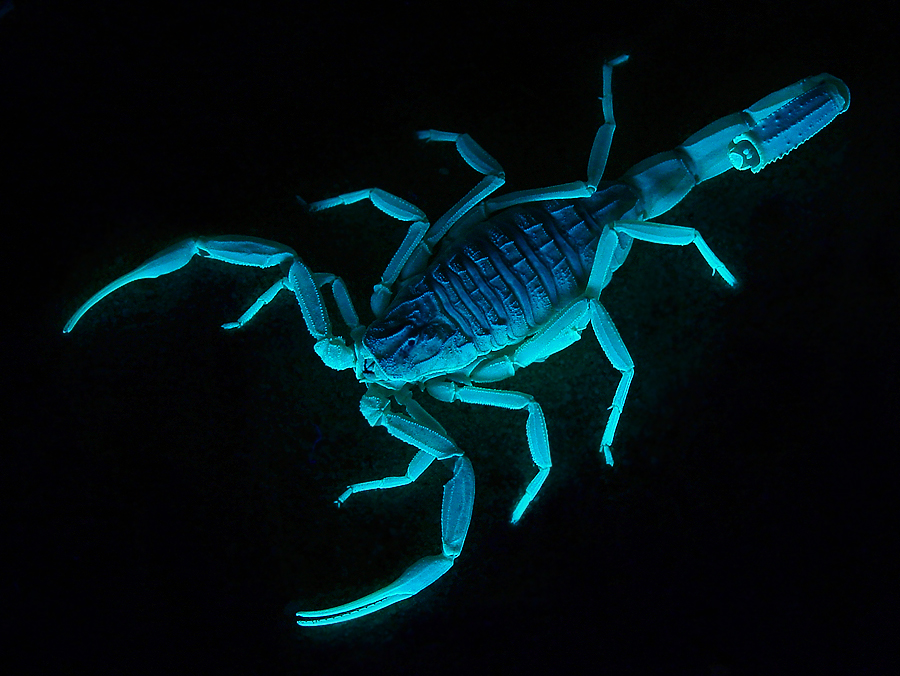
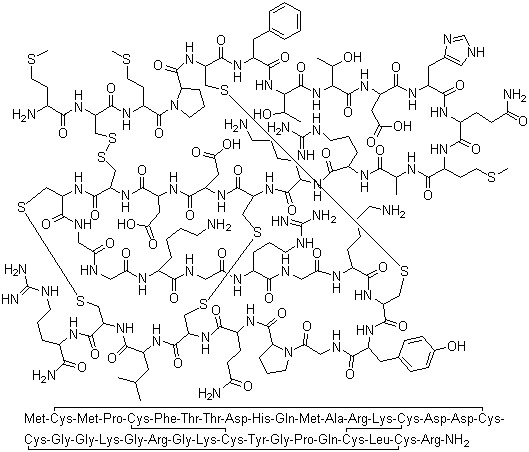
Molecular formula: C158H249N53O47S11
Woah. Take a look at this 36 amino-acid peptide monster. Who is the beast responsible for this? Look no further, Chlorotoxin is produced and found in the toxic venom of the Deathstalker Scorpion, the deadliest of its species. Here's the little bastard in question, poised and ready:
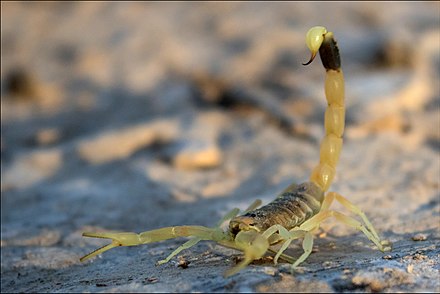
I wanted to give the Deathstalker some spotlight before we break down its toxins (it's not everyday I get a captive audience for bugs AND chemistry), so I did some reading about the creature in an article by Lancelot Tucker for DesertUSA [1]. The Deathstalker is about the size of your average scorpion: 1-3 inches. They're noctural heat-lovers that are native to the Middle East and Northern Africa/sahara region. And like most scorpions, they get all glowy under ultraviolet light!

I think they're pretty neat!
As for their 'danger level'...
I couldn't find them on any 'top 10 most lethal insects' lists, and Tier Zoo DID rank the scorpion species as a whole at D TIER (they are kinda outmatched BUT STILL!!), yet their poor ranking doesn't mean their sting is just a slap on the wrist. The Deathstalker's venom is composed of several neurotoxins, such as Charybdotoxin, a chemical that causes hyper-excitable nerves. One sting will induce extreme pain and vomitting in most adults, and more vulnerable victims can experience fluid retention in the lungs and/or cardiac arrest [1]. But the toxin where my interests lie, Chlorotoxin, belongs to a family of peptides titled 'insectotoxins' that are selectively paralytic to insects and invertebrates [3].
If you're interested in the mechanics of a scorpion stinger, there's a pretty great study on it here
I mean, take a look at this wacky ass stinger on a micrometer scale:
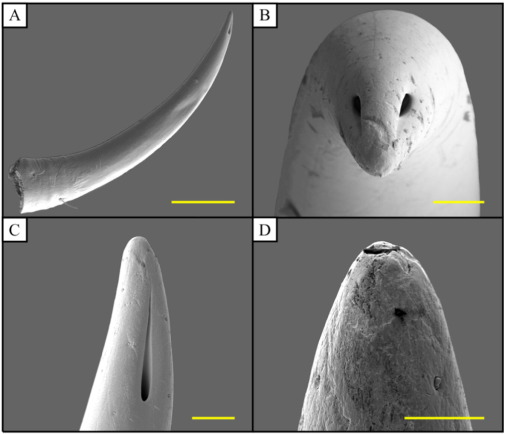
In the section of the study titled potential biomedical applications (4.5), they theorize that the functionality and technique of a Scorpion's sting could improve medical needles by penetrating tougher tissues and lessening pain with a cleaner entry. Bone marrow biopsies in particular could benefit from this technology due to the marrow being incredibly sensitive to pain, and - well - jabbing a needle in your bones is just as bad as it sounds.
But to sadly shift our focus away from insects and back to Chlorotoxin...
When chlorotoxin is isolated and administered by medical professionals and NOT a peeved scorpion, the chemical is extremely useful with targeting, identifying, and diagnosing glioma - brain and spinal cord tumors.
Chlorotoxin originally got its name for its nature of blocking chloride ion channels in the cellular transport system, but that was only true for the embryotic rat brains that were initially tested [3]. As the peptide was further studied, the definition fell apart as not all chloride-channels expressed in tested humans were being inhibited by Chlorotoxin, including normal brain tissue [3]. Strangely enough, Chlorotoxin was soon noticed to have an affinity for binding to small and unique chloride channels in gliomas which had been confirmed with the use of flourescent dye [3]. From a pharmaceutical perspective, identifying tumor cells would allow therapeutic agents to be delivered directly and precisely, greatly expanding viable attacking methods. Localizing and targeting gliomas has been challenging in the past due to their genetic and antigenic variability, but chlorotoxin is consistent across all variations [2].
This 'tumor paint' is still in testing and development, but the results plan to have cancerous cells glowing through the lens of an infrared camera!
So anything else going on between chlorotoxin and glioma? We gotta turn to more speculation and biology... and this goofy diagram I guess. Hear me out.
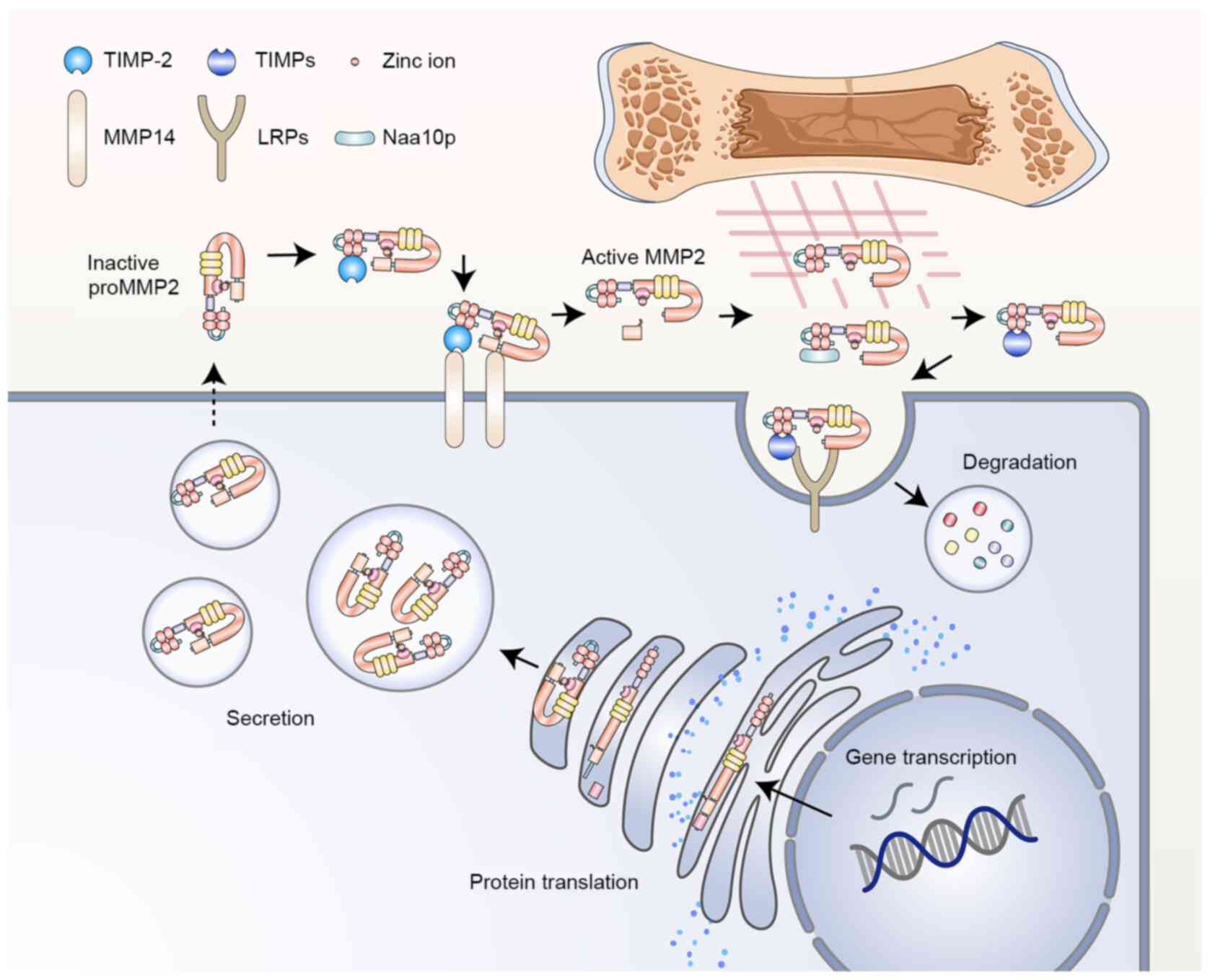
Alright, so there's this thing called the 'extracellular matrix' that gliomas like to rework for themselves. That space in the diagram outside the 'blue area' is that matrix, and it's full of proteins and fibers and such. Extracellular matrixes interact with cell adhesion receptors to form their own network between cells, which is responsible for creating tissues and organs [5]. When glioma infiltrates a brain, an enzyme known as 'matrix metalloproteinase-2' (MMP2) gets upregulated in a matrix it isn't typically expressed in [4]. This overexpression has been listed as a cause to the tumor's relative malignancy, or the ability to spread to different parts of the body [6]. Simply stated, brain tumor networks are chemically different than normal brain tissue networks.
Turns out Chlorotoxin LOVES to inhibit MMP2 by binding to its receptors on the cell surface [4]. The result is the reduction in MMP2 expression, which in turn decreases the tumor's malignancy [4]. So it seems that Chlorotoxin gets another card in its indeterminately large deck! While it might not be killing the cancer cells, it can calm them... and to touch on a point earlier, therapeutic agents can theoretically (and expensively) be synthesized with the binding properties of chlorotoxin to deliver directly to these less malignant gliomas [2].
Now things get a little weird because I haven't been able to currently confirm FDA approval for use of the toxin outside of a laboratory. Developments at the moment are kinda up in the air, but I'm guessing 'tumor paint' is gonna break the mold sooner or later when we get the technology right.
Annnnd there ya go! I have 0 experience with biochemistry, so this article is probably not as scientifically correct as I would hope and I can't theorize too much without sounding like a loon... But I DID get a chance to rep this epic scorpion and its growing impact in the fight against cancer! Who would have thought the deadliest scorpion had it in 'em? I see it as a reminder that we're capable of finding the good in many things, and that extends beyond just scary bugs! [WIP]
Images: Chlorotoxin Chemical Composition, Scorpion!!, Glowing Scorpion!! , Scorpion Stinger , MMP2
[1] The Deathstalker Scorpion: One of the Most Dangerous Scorpions for Humans
[2] Chlorotoxin: A Helpful Natural Scorpion Peptide to Diagnose Glioma and Fight Tumor Invasion
[3] Chlorotoxin: Structure, activity and potential uses in cancer therapy
[4] Chlorotoxin Inhibits Glioma Cell Invasion via Matrix Metalloproteinase-2*
[5] The Role of Extracellular Matrix in Tissue Regeneration
[6] MMP2 is associated with glioma malignancy and patient outcome